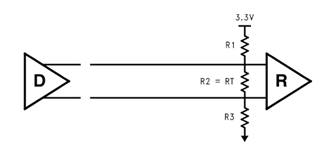Other Parts Discussed in Thread: DS90LV012A, SN74LVC1G04
Tool/software:

This thread has been locked.
If you have a related question, please click the "Ask a related question" button in the top right corner. The newly created question will be automatically linked to this question.
Tool/software:

To output low, both the DS90LV012A and the DS90LV048A require a differential input voltage of less than −100 mV.
RT is 100 Ω, so the current must be more than 0.1 V / 100 Ω = 1 mA. With R1 = R3 = 1.2 kΩ, the current would be 3.3 V / (1.2 kΩ + 100 Ω + 1.2 kΩ) = 1.32 mA.
Please note that if the two signal lines are shorted together, then the differential input voltage is 0 V, and the receiver outputs high; no resistor can change that. An alternate solution to get a fail-safe low value would be to remove R1/R3, exchange the +/− inputs, and add an inverter (e.g., SN74LVC1G04).
Hello,
Please refer to this post with another interested in this application: DS90LV048A: Output LOW on Fail-safe - LVDS Rx
Here is another good reference on this topic: AN-1194 Failsafe Biasing of LVDS Interfaces (Rev. C) (ti.com)
Sincerely,
Amy